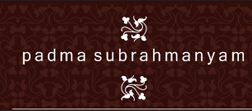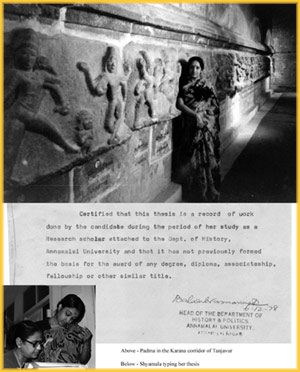

|
ESSENCE OF HER RESEARCH She
is the first to bridge the gap between theory and practice. She
has revived an obsolete dance technique, translating theoretical
concepts into practice. Post-Independent India had seen the revival of various ("Desi") dance forms such as Bharatanatyam, Kathakali, Kuchipudi, Odissi, Kathak, Manipuri etc., |
 |
|
Padma is the first to discover the long forgotten grammatical artistic base in "Marga" ie., the path shown by Sage Bharata, common to all "Desi" forms. Like how the Sanskrit language co-existed with all the regional languages, the Marga had co-existed with all the Desis till about five centuries ago. Padma has revived this Marga technique, common to the entire Indian sub-continentand even Asia. Based on her research, she announces her programmes as"Bharata Nrityam". Also, with the same communication technique and using the language of the respective regions, she has choreographed Bharata Nrityam recitals in Tamil, Kashmiri, Hindi, Bengali, Oriya, Marathi, Kannada, Telugu and Malayalam languages. She has also used songs from other foreign languages to demonstrate the "Abhinaya" (communication) technique. ---------------------------------------------------------------------------------------------------------------------------------------- |
|
|
SATARA (MAHARASHTRA) & PRAMBANAN (INDONESIA) Padma was ordained by the great Centenarian Sage of this century, Pujyasri Chandrasekharendra Saraswati Swamigal, Jagadguru Sankaracharya (68th) of Kanchi Kamakoti Peetam, to design a new set of 108 Karana sculptures of Lord Shiva and Goddess Parvati in black Granite, for a temple of Lord Nataraja built recently at Satara in Maharashtra. |
 |
|
His Holiness asked her to freeze those movements of Karanas which are not sculpted in the older temples of Tanjavur, Kumbakonam and Chidambaram (all in Tamilnadu). Padma made use of 'the twin figures of Shiva and Parvati' to bring out the animation of each of the Karana movements. Twelve years after completing her design of these 108 Karana figures, she discovered by the grace of the Sage of Kanchi, about fifty Karana sculptures in the world renowned monument-temple complex at Prambanam in Cental Java, Indonesia, belonging to the 9th century AD, The remarkable historic feature of these figures is that they totally tally with Padma's practical reconstruction of the Karana movements and also have great similarity with her own designs for the temple at Satara. She has thus been blessed with an irrefutable prrof for the authenticity of her reconstruction of the Karanas. This "link beyond time and space" is the subject of a book by an Italian archaeologist Dr. Alessandra, who did her Post-Doctoral research under Padma, through the British Academy, London. ---------------------------------------------------------------------------------------------------------------------------------------- |
|
|
ASIAN LINKS Apart from discovering candid links between Natya Sastra and Indonesia, Padma realised through the lectures of Pujyasri Mahaswami of Kanchi, the importance of ancient Tamil literature "Tiruppavai" & "Tiruvempavai" being used in Thailand, where she used these inher group presentation " Pavai Nonbu", also involving Thai dancers along with her own artistes. She also gave a joint lecture-demonstration on Natya Sastra at the College of Fine Arts, Bangkok along with Achan Chaturong Montri Sat, Thai Professor of Dance. Similarly, her visits to Japan and Australia have considerably strengthened her conviction about Asia's common cultural links.
|
|